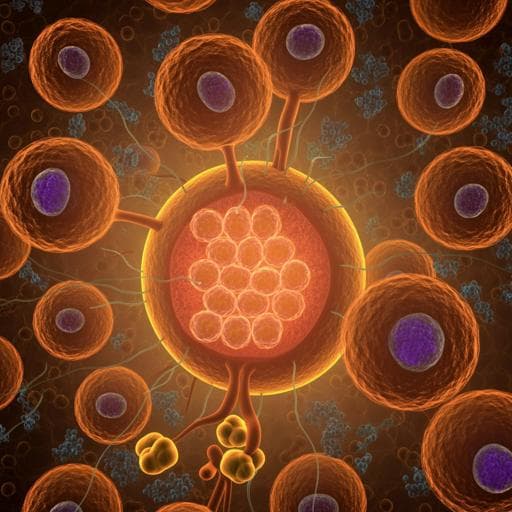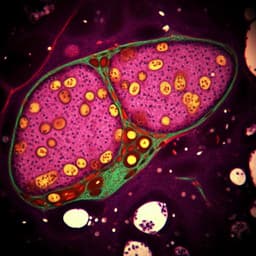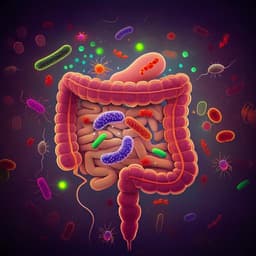
Medicine and Health
Pyruvate dehydrogenase kinase 1 and 2 deficiency reduces high-fat diet-induced hypertrophic obesity and inhibits the differentiation of preadipocytes into mature adipocytes
H. Kang, B. Min, et al.
This groundbreaking research reveals the critical role of pyruvate dehydrogenase kinases (PDK1/2) in diet-induced obesity. Mice deficient in PDK2 exhibited remarkable resistance to obesity, showcasing reduced fat accumulation and enhanced insulin sensitivity. The study, conducted by notable researchers including Hyeon-Ji Kang and Byong-Keol Min, uncovers novel regulatory mechanisms of adipogenesis linked to HIF1α and lactate production, offering fresh insights into obesity management.
~3 min • Beginner • English
Introduction
Obesity remains highly prevalent and difficult to treat, highlighting the need to elucidate adipocyte biology underlying pathological fat accumulation. Adipocytes expand and store triacylglycerol to buffer energy excess, but excessive hypertrophy and hyperplasia contribute to obesity-related metabolic disease. Pyruvate dehydrogenase kinase 2 (PDK2), a mitochondrial kinase regulating the pyruvate dehydrogenase complex, maintains euglycemia during starvation yet contributes to hyperglycemia in diabetes. Prior studies showed that PDK2 deficiency reduces body weight gain and hepatic steatosis and increases hepatic fatty acid oxidation, ketogenesis, and energy expenditure in high-fat diet (HFD)-fed mice. The present study tests the hypothesis that PDK2—and more broadly PDK1/2—regulates adiposity via cell-intrinsic control of adipocyte differentiation. Specifically, the authors examine whether global or adipose-specific Pdk2 deficiency protects against HFD-induced hypertrophic obesity and whether PDK1/2 induction is required for differentiation of preadipocytes into mature adipocytes, potentially via a lactate–HIF1α mechanism.
Literature Review
Background work implicates PDK2 in multiple metabolic and disease contexts: its inhibition or deletion lowers blood glucose and improves insulin sensitivity in diabetes models, suppresses HIF1α signaling and angiogenesis in cancer, modulates macrophage polarization toward M1, and participates in p53-mediated apoptosis. Prior data from the authors indicated that PDK2 deficiency diminishes HFD-induced weight gain and hepatic steatosis while enhancing hepatic fat oxidation and energy expenditure. Adipogenesis involves extensive chromatin remodeling and transcription factor networks (e.g., PPARγ, C/EBP family), with epigenetic marks such as H3K27ac and H3K4me3 marking active regulatory regions. Paradoxically, while HFD can increase adipogenic/lipogenic gene expression in mice, obese humans often exhibit decreased adipogenic gene expression in adipose tissue. HIF1α has been reported to rise during adipogenesis and in obese adipose tissue, and lactate can stabilize HIF1α and promote glycolytic reprogramming. These studies frame the investigation into whether PDK1/2 link metabolic flux (glycolysis/lactate) with HIF1α signaling to drive adipocyte differentiation and obesity.
Methodology
Animal studies: Pdk2lox/+ mice (C57BL/6 background) were engineered with LoxP sites flanking exon 2 of Pdk2 and intercrossed to generate Pdk2lox/lox mice. Adipocyte-specific PDK2 knockout mice (Pdk2ad-/-) were created by crossing Pdk2lox/lox with Adipoq-Cre mice (adiponectin-Cre). Global Pdk2 and Pdk4 knockout mice were also used. Mice were maintained on a 12-h light/dark cycle at 22 ± 2 °C. Starting at 4 weeks of age, mice were fed either a low-fat diet (LFD; 10 kcal% fat, D12450B) or a high-fat diet (HFD; 60 kcal% fat, 6 kcal% sucrose, D12492). Body composition (lean and fat mass) was measured with a MiniSpec LF 50 analyzer. Computed tomography scans assessed fat depots. All procedures were approved by IACUCs of Kyungpook National University (2015-0063) and DGMIF (DGMIF 19020704-00).
Metabolic tests: Glucose tolerance tests (1.5 g/kg i.p. D-glucose) after 16 h fasting and insulin tolerance tests (0.75 U/kg i.p. insulin) after 6 h fasting were performed with serial tail blood glucose measurements.
Histology and immunofluorescence: White adipose tissue (WAT) was fixed in 4% formaldehyde, paraffin-embedded, H&E-stained, and adipocyte area quantified by ImageJ. Perilipin immunofluorescence used anti-perilipin A and Alexa Fluor-568 secondary antibody with confocal imaging.
Cell culture and differentiation: 3T3-L1 preadipocytes were cultured in high-glucose DMEM + 10% bovine serum. Differentiation was induced at confluence with insulin (1 µg/ml), dexamethasone (1 µM), IBMX (0.5 mM), and 10% FBS for 2 days, followed by 10% FBS + insulin medium changes every 2 days. Oil Red O staining assessed lipid accumulation on day 6. Pharmacologic agents included dichloroacetate (DCA; pan-PDK inhibitor), sodium L-lactate, chetomin (HIF1α inhibitor), and GSK2837808A (LDH inhibitor).
Molecular analyses: Western blots probed adipogenic markers (SREBP-1c, FAS, C/EBPα, PPARγ), PDK isoforms (PDK1–4), PDHE1α phosphorylation (Ser232/Ser293), HIF1α, HSP90, and β-tubulin. qPCR quantified mRNA expression; primers in Supplementary Table 1.
ChIP assays: Performed in 3T3-L1 cells across differentiation to evaluate histone acetylation/methylation marks (H3/H4 acetylation, H3K4me3, H3K27ac) and HAT recruitment (PCAF, p300) at Pdk1 and Pdk2 promoters; ChIP-seq data from GSE20752 supplemented.
Genetic manipulation: Retroviral overexpression of Pdk1 or Pdk2 (Vxy-puro vectors) in 3T3-L1 cells; stable selection with puromycin. Stable knockdown of Pdk1 and/or Pdk2 via shRNA plasmids (Qiagen) with selection by puromycin/hygromycin.
Metabolic flux readouts: Extracellular L-lactate measured by EnzyChrom kit over differentiation; ECAR quantified as a surrogate for glycolysis; glucose consumption from culture supernatant.
Human samples: Visceral adipose tissue from 34 healthy kidney donors (IRB B-1801-445-301) was analyzed for correlations between PDK isoform expression, adipogenic gene expression (e.g., PPARγ, SREBP-1c), and BMI; baseline characteristics in Supplementary Table 2.
Statistics: Data plotted in GraphPad Prism 8.3; analyses in IBM SPSS v21. Two-tailed Student’s t-test for normally distributed data; one- or two-way ANOVA with LSD post hoc for group comparisons. Significance threshold p < 0.05.
Key Findings
- Global Pdk2 knockout reduces adiposity: After 6 weeks HFD, Pdk2−/− mice showed significantly attenuated body weight and fat mass gain versus WT, unlike Pdk4−/− mice. CT imaging and body composition confirmed reduced visceral and subcutaneous fat across diets. Under HFD, fat mass percentage reduced from 20.8 ± 0.9% (WT, n=6) to 14.7 ± 1.2% (Pdk2−/−, n=6); under LFD, slight reduction from 13.5 ± 0.9% (WT, n=5) to 10.4 ± 0.2% (Pdk2−/−, n=6).
- Adipocyte hypertrophy decreased: H&E and perilipin staining of epididymal WAT in HFD-fed mice showed a 26% reduction in adipocyte area in Pdk2−/− (33.5 ± 1.1 to 24.8 ± 1.9 ×10^2 μm²).
- Adipocyte-specific Pdk2 deletion lowers fat mass: Pdk2ad−/− mice (Adipoq-Cre; Pdk2lox/lox) had reduced body weight and decreased subcutaneous and epididymal fat mass under both LFD and HFD, with smaller adipocytes histologically.
- Glycemic effects: Unlike global KO, Pdk2ad−/− mice displayed only slight improvement in insulin sensitivity (ITT) and no improvement in glucose tolerance (GTT) under HFD; serum triglycerides and free fatty acids were reduced. Energy expenditure, RER, VO2/VCO2, food intake, and activity were not significantly different, indicating reduced adiposity was not due to increased metabolic rate.
- PDK1/2 upregulated during adipogenesis: In 3T3-L1 differentiation, Pdk1 and Pdk2 mRNA and protein rose markedly, whereas Pdk3/4 did not change. Primary stromal vascular cell differentiation showed similar induction of Pdk1/2. Epigenetic activation evidenced by increased H3K27ac at TSS regions, increased H3K4me3 and H3K36me3 across gene bodies, and recruitment of HATs (PCAF, p300) with enhanced H3/H4 acetylation at Pdk1/Pdk2 promoters.
- Functional necessity and sufficiency: Overexpression of Pdk1 or Pdk2 increased lipid accumulation by ~62% and elevated adipogenic markers (C/EBPα, PPARγ, SREBP-1c). Single knockdown of Pdk1 or Pdk2 modestly reduced adipogenesis (~10–20%), while dual knockdown of Pdk1/2 profoundly inhibited adipogenesis and downregulated adipogenic genes. Pan-PDK inhibition with DCA reduced PDHE1α phosphorylation and inhibited differentiation in a dose-dependent manner.
- PDK1/2 drive glycolytic shift and lactate-HIF1α axis: Differentiation increased glucose consumption, lactate release, and ECAR; these increases were blunted in shPdk1/2 cells. Exogenous lactate stabilized HIF1α protein in a dose-dependent manner without increasing Hif1a mRNA. Pdk1/2 overexpression elevated HIF1α protein during differentiation; shPdk1/2 prevented its stabilization. HIF1α inhibition (chetomin or siRNA) reduced Pdk1/2-mediated adipogenesis and adipogenic gene expression. LDH inhibition (GSK2837808A) lowered extracellular lactate and suppressed adipogenesis despite Pdk1/2 overexpression, supporting a PDK–lactate–HIF1α pathway.
- Human and mouse adipose correlations: In human visceral adipose tissue (n=34), PDK1 and PDK2 mRNA levels inversely correlated with BMI; PPARγ and SREBP-1c also inversely correlated with BMI. PDK1/2 expression positively correlated with PPARγ. In mice, chronic HFD decreased adipose PDK1/2 protein levels, while PDK4 increased.
Discussion
The findings demonstrate that PDK2, and more broadly PDK1/2, are critical regulators of adiposity and adipocyte differentiation. Global and adipocyte-specific Pdk2 deletion protected against HFD-induced fat accumulation and adipocyte hypertrophy, with adipocyte-specific effects occurring independently of changes in energy expenditure. Mechanistically, adipogenic differentiation requires induction of PDK1 and PDK2 through epigenetic activation at their loci. PDK1/2 augment glycolytic flux, increasing lactate production, which stabilizes HIF1α; HIF1α in turn supports adipogenic gene programs, establishing a PDK–lactate–HIF1α axis essential for adipogenesis. Genetic or pharmacologic disruption at multiple nodes (PDK inhibition, dual Pdk1/2 knockdown, HIF1α inhibition, LDH inhibition) attenuated lipid accumulation and adipogenic marker expression, underscoring pathway necessity. The positive correlation between PDK1/2 and PPARγ in human adipose tissue aligns with their role in adipogenesis, while the inverse correlation of PDK1/2 (and PPARγ) with BMI and decreased PDK1/2 in HFD-fed mice suggest impaired adipogenic differentiation in severe obesity, with compensatory increases in PDK4 to support alternative substrate use and PDH inhibition. The data also suggest potential bidirectional crosstalk, as HIF1α can transcriptionally regulate PDKs, possibly reinforcing glycolytic reprogramming. Overall, restricting PDK1/2 activity limits preadipocyte-to-adipocyte differentiation and adipocyte hypertrophy, addressing the central hypothesis and linking mitochondrial pyruvate flux control to adipose tissue expansion.
Conclusion
This study identifies PDK1 and PDK2 as epigenetically induced, functional drivers of adipocyte differentiation and hypertrophic obesity. Adipose-specific Pdk2 deficiency reduces fat mass and adipocyte size and modestly improves insulin sensitivity under HFD without altering energy expenditure. In vitro, PDK1/2 are necessary and sufficient to enhance adipogenesis via increased glycolysis and lactate-mediated stabilization of HIF1α. Human adipose data corroborate associations between PDK1/2 and adipogenic capacity. These findings propose PDK1/2 as therapeutic targets; pharmacological inhibition of PDK1/2 may help prevent or treat obesity by limiting adipogenesis and adipocyte hypertrophy. Future research should include generating adipose-specific Pdk1 and combined Pdk1/2 knockout models to delineate individual and synergistic roles in vivo, further dissecting transcriptional regulation (e.g., JUN/FOS involvement) of Pdk1/2 during early adipogenesis, and elucidating detailed mechanisms of lactate-HIF1α signaling in adipocyte lineage commitment.
Limitations
- The study did not include adipose tissue-specific Pdk1 knockout or combined adipose-specific Pdk1/2 knockout mice, limiting in vivo assessment of PDK1’s role and potential synergy with PDK2.
- Some in vitro findings (e.g., requirement for dual Pdk1/2 knockdown) may not fully recapitulate in vivo physiology.
- Human data are cross-sectional correlations from a modest sample of kidney donors (n=34), which preclude causal inference and may not generalize to broader populations or different adipose depots.
- Energy expenditure assessments suggest no difference, but more detailed metabolic phenotyping (e.g., thermogenesis, substrate oxidation rates) could provide additional insight.
Related Publications
Explore these studies to deepen your understanding of the subject.







